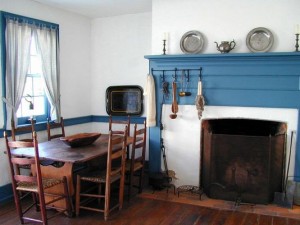Sasso: Our history informs our future
(Indianapolis Star, July 3, 2016)

The kitchen of the Levi Coffin House in Fountain City, known as “the Grand Central Station of the Underground Railroad.”
(Photo: IndyStar)
On July 4, we light grills and fireworks, wave flags and gather with friends and family. This holiday, celebrating our nation’s deeply cherished freedoms, offers the perfect opportunity to reflect on two Hoosiers who fought for liberty in the 19th century, when freedom’s reach embraced some, but not all.
In the 1800s, Levi and Catharine Coffin’s house in Fountain City served as a waystation for thousands of Freedom Seekers who made the terrifying journey north in search of a new life. Levi and Catharine were Quakers, dedicated to the idea of equality, regardless of race. Their home was known as the “Grand Central Station” of the Underground Railroad. As prominent business owners, they risked their own lives, relationships and reputations to bring freedom to those who had been denied that right.
The Coffins’ home was a house built on secrets. It was constructed with an interior well to disguise how much water was being drawn from it. Concealed behind a bed was a door to a tiny room under the eaves of the house, where it was possible for slaves to hide from bounty hunters. Every Freedom Seeker who sought shelter in the Coffin house left safely. Many of them arrived and departed in the false-bottomed wagon Levi had designed and built for that purpose. Levi and Catharine Coffin were concerned with the futures of those they helped to become free, not with any legacy of their own. Their dedication to the American values of compassion and justice deserves remembering.
Our nation is at a crossroads. We stand looking back on a history of courage and vision that we have yet to fully realize. As we celebrate our own state’s bicentennial, this Fourth of July, beyond cookouts and fireworks, is a time to reflect on how far we have come and look ahead to the work that still needs to be done.
The Coffins did not labor alone. The community around them – fellow Quakers, like-minded Hoosiers, and even Freedom Seekers who stayed behind to help – banded together to assist them in their efforts. The cause united them in the face of wrong-doing and oppression, giving them the courage to stand strong for human dignity and freedom and to make a difference in the lives of those who suffered under the unjust laws and practices of the time.
Sometimes, the best way to reflect on that history is to look it in the eye, especially when it’s waiting in our own back yard. Less than two hours from Indianapolis, the Levi Coffin House still stands. Its walls are lined with untold stories that serve as a reminder of the past and an inspiration for the future. This nationally recognized State Historic Site welcomes visitors, giving them an opportunity to see this remarkable history first-hand. Visitors to the Levi Coffin House are able to witness the role it played in the lives of so many who called it home – no matter how briefly – during a tumultuous and challenging time. We stand at such a time once again. A visit to this house is an important reminder of what our present task should be.
The Levi Coffin House State Historic Site is currently open to the public June through August, from 1 to 4 p.m. Tuesday through Saturday. After December, when the Indiana State Museum and Historic Sites unveils their brand-new, state-of-the-art interpretive center next door to the Coffin House, the site will be open year-round. For more information on how to visit this remarkable piece of history, visit www.indianamuseum.org/explore.
Sasso is rabbi emeritus of Congregation Beth-El Zedeck and director of the Religion, Spirituality and the Arts Initiative at Butler University.



